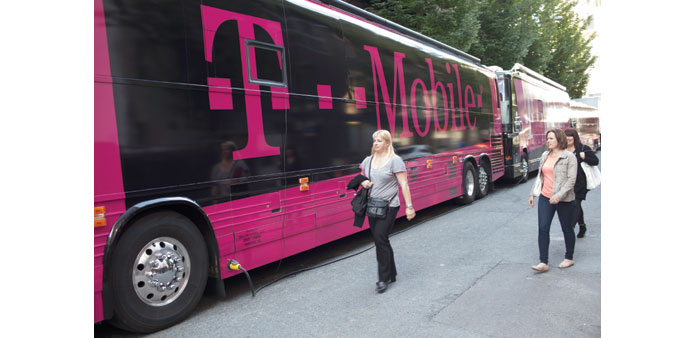Women walk past buses displaying T-Mobile US logos outside the Paramount Theatre during a T-Mobile event in Seattle, Washington, on June 18, 2014. The self-billed US-carrier has increased its monthly subscriber base by 36% in the past seven quarters.
Bloomberg
New York
Sprint Corp’s earnings report today may reveal what T-Mobile US Inc chief executive officer John Legere has been predicting for months — that T-Mobile has overtaken Sprint to join the top three US wireless carriers.
Given the subscriber growth rate of Bellevue, Washington-based T-Mobile, there’s an air of inevitability that suggests if today isn’t the day, it won’t be much further off.
The self-billed US-carrier has increased its monthly subscriber base by 36% in the past seven quarters, while Sprint’s fell 2.4% as of the end of 2014. T-Mobile’s popularity picked up pace after Twitter-fluent industry-rebel Legere took over. He banished two-year contracts in favour of no- money-down phone financing and followed with benefits like free music streaming and data rollover. Industry leaders Verizon Communications and AT&T responded with similar offers or dangled free tablets to help keep customers.
“This will give Legere more bragging rights,” said John Butler, an analyst with Bloomberg Intelligence. “He’s earned it. He brilliantly turned a no-name brand into a cool, hip brand by fostering his own anti-establishment image.”
T-Mobile reported last week that it had 56.8mn total subscribers at the end of March, exceeding the 55.9mn that Overland Park, Kansas-based Sprint had at the end of last year.
A possible silver lining for Sprint is that it will still have more lucrative monthly subscribers than T-Mobile. Analysts predict Sprint lost 2,800 monthly subscribers in its fiscal fourth quarter which ended in March, according to a Bloomberg survey of five estimates. That would leave Sprint little changed at 29.9mn postpaid users compared with 28.3mn at T- Mobile.
T-Mobile’s growth has come at a cost.
Since Deutsche Telekom-controlled T-Mobile started the price battle, it has posted net losses in six of the past eight quarters, including the most recent period. Margins have been pinched industrywide as other carriers struggle to keep up with T-Mobile’s promotions.
For Sprint, the slip in standings comes at a challenging time as the company struggles to shake off a seven-year stretch of subscriber losses, largely a fallout from its failed merger with Nextel.
Sprint, controlled by Tokyo-based SoftBank Corp, is in the early stages of a turnaround effort led by Chief Executive Officer Marcelo Claure. The former CEO of mobile phone distributor Brightstar, Claure was hand-picked by SoftBank CEO Masayoshi Son to lead Sprint back to growth.
He introduced a “cut-your-bill-in-half” offer aimed at Verizon and AT&T customers, a new push to attract business users and a house-call service to guide users through device upgrades.
Under Claure, Sprint has also cut more than 2,000 employees and made a deal to expand its retail reach to more than 1,000 RadioShack Corp stores. In September, Claure refocused a network expansion effort to strengthen signals in a handful of cities instead of its previous broader-blanket approach to coverage.
Competing on service quality is Sprint’s best chance at success, said Walt Piecyk, an analyst with BTIG LLC in New York.
“Network quality plays a key role,” Piecyk said. “I’m sure they have a network strategy that will get them to the point where they can start taking meaningful market share.”

